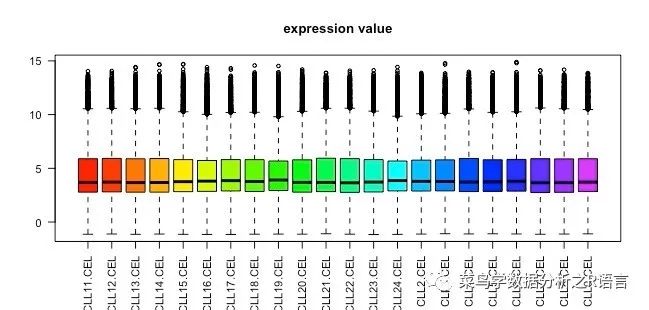您好,登录后才能下订单哦!
本篇文章为大家展示了如何进行limma对基因芯片数据基因差异表达分析,内容简明扼要并且容易理解,绝对能使你眼前一亮,通过这篇文章的详细介绍希望你能有所收获。
limma
>suppressPackageStartupMessages(library(CLL))
> data(sCLLex)
> exprSet=exprs(sCLLex) ##sCLLex是依赖于CLL这个package的一个对象
> samples=sampleNames(sCLLex)
> pdata=pData(sCLLex)
> group_list=as.character(pdata[,2])
> dim(exprSet)
[1] 12625 22
> exprSet[1:5,1:5]
CLL11.CEL CLL12.CEL CLL13.CEL CLL14.CEL CLL15.CEL
1000_at 5.743132 6.219412 5.523328 5.340477 5.229904
1001_at 2.285143 2.291229 2.287986 2.295313 2.662170
1002_f_at 3.309294 3.318466 3.354423 3.327130 3.365113
1003_s_at 1.085264 1.117288 1.084010 1.103217 1.074243
1004_at 7.544884 7.671801 7.474025 7.152482 6.902932
> par(cex = 0.7)
> n.sample=ncol(exprSet)
> if(n.sample>40) par(cex = 0.5)
> cols <- rainbow(n.sample*1.2)
>boxplot(exprSet, col = cols,main="expression value",las=2)

> suppressMessages(library(limma))
> design <- model.matrix(~0+factor(group_list))
> colnames(design)=levels(factor(group_list))
> rownames(design)=colnames(exprSet)
> design
progres. stable
CLL11.CEL 1 0
CLL12.CEL 0 1
CLL13.CEL 1 0
CLL14.CEL 1 0
CLL15.CEL 1 0
CLL16.CEL 1 0
CLL17.CEL 0 1
CLL18.CEL 0 1
CLL19.CEL 1 0
CLL20.CEL 0 1
CLL21.CEL 1 0
CLL22.CEL 0 1
CLL23.CEL 1 0
CLL24.CEL 0 1
CLL2.CEL 0 1
CLL3.CEL 1 0
CLL4.CEL 1 0
CLL5.CEL 1 0
CLL6.CEL 1 0
CLL7.CEL 1 0
CLL8.CEL 1 0
CLL9.CEL 0 1
attr(,"assign")
[1] 1 1
attr(,"contrasts")
attr(,"contrasts")$`factor(group_list)`
[1] "contr.treatment"
>contrast.matrix<makeContrasts(paste0(unique(group_list),collapse = "-"),levels = design)
> contrast.matrix
Contrasts
Levels progres.-stable
progres. 1
stable -1
> fit <- lmFit(exprSet,design)
> fit2 <- contrasts.fit(fit, contrast.matrix) ##这一步很重要,大家可以自行看看效果
> fit2 <- eBayes(fit2)
> tempOutput = topTable(fit2, coef=1, n=Inf)
> nrDEG = na.omit(tempOutput)
> head(nrDEG)
logFC AveExpr t P.Value adj.P.Val B
39400_at -1.0284628 5.620700 -5.835799 8.340576e-06 0.03344118 3.233915
36131_at 0.9888221 9.954273 5.771526 9.667514e-06 0.03344118 3.116707
33791_at 1.8301554 6.950685 5.736161 1.048765e-05 0.03344118 3.051940
1303_at -1.3835699 4.463438 -5.731733 1.059523e-05 0.03344118 3.043816
36122_at 0.7801404 7.259612 5.141064 4.205709e-05 0.10619415 1.934581
36939_at 2.5471980 6.915045 5.038301 5.362353e-05 0.11283285 1.736846
上述内容就是如何进行limma对基因芯片数据基因差异表达分析,你们学到知识或技能了吗?如果还想学到更多技能或者丰富自己的知识储备,欢迎关注亿速云行业资讯频道。
免责声明:本站发布的内容(图片、视频和文字)以原创、转载和分享为主,文章观点不代表本网站立场,如果涉及侵权请联系站长邮箱:is@yisu.com进行举报,并提供相关证据,一经查实,将立刻删除涉嫌侵权内容。